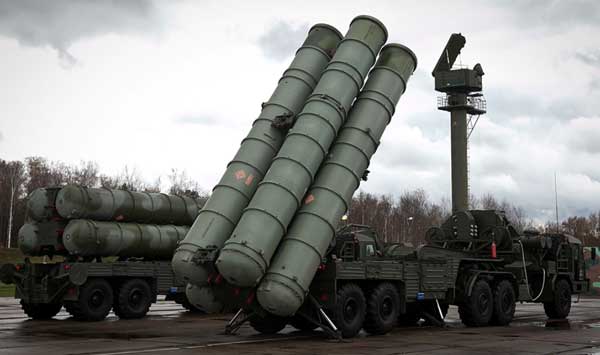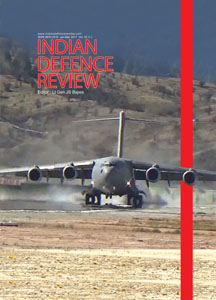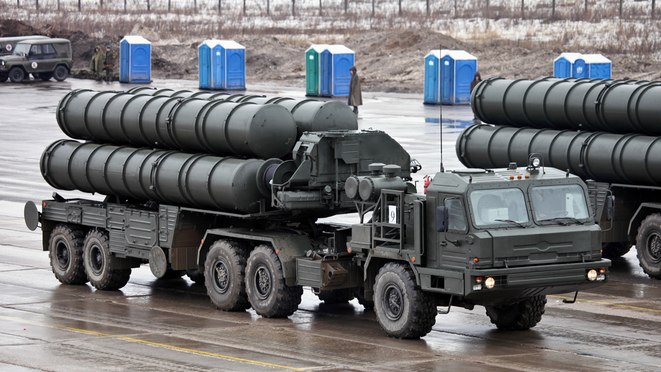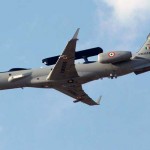The proposed acquisition of the S-400 Triumf will undoubtedly impact capability of the adversary in conducting air operations and will be a valuable constituent of the Indian air defence architecture. It is expected to enter service by 2020 and may complete induction in five to six years. The system has a place in the architecture along with other systems required to safeguard the Indian air space. This system will create the desired advantage only as part of the architecture.
The S-400 is expected to cost $6.1 billion for five systems – the most expensive air defence system ever bought by India…
A news item in the Economic Times of March 12, 2016 read, “In a rare exercise, India’s air defence plans have been altered after intervention by Defence Minister Manohar Parrikar that may have saved the taxpayer Rs 49,300 crore in acquisitions over the next decade. Faced with the high cost of acquiring the Russian S-400 long range missile shield – the cutting edge system that can bring down incoming stealth fighters and missiles at a range of 380 km – the minister ordered a review of the 15-year long term plan to purchase new air defence systems up to 2027. The study found that India will require a much lesser number of the shorter range systems. Minister Parrikar convinced the Indian Air Force (IAF) that according to its layered defence plan, the long range S-400 system would make the larger number of MR-SAM and SR-SAM redundant. The S-400 is expected to cost $6.1 billion for five systems – the most expensive air defence system ever bought by India. But, on a per square km covered basis, it is the cheapest of known systems available”1
An Unexplained Revaluation
The foregoing news item speaks of two issues. Firstly, the possibility of India acquiring the S-400 Triumph, an ultra-modern ground-based Russian air defence weapon system and secondly, about a revaluation done to establish afresh, a reduced long term requirement of ground-based air defence weapons for the armed forces. The report credits the Defence Minister with a massive saving in defence expenditure by deleting some proposed acquisitions of ground-based air defence weapon systems.
Some disquieting questions raised by this news item will be identified and elaborated in the following text, but first an important and a novel aspect must be highlighted. We have a never ending acquisition process. While there is a running argument between the bureaucrats who never understand the technology or the urgency for acquiring a weapon system, but control the purse strings and the process of acquisition. The users on the other hand, constantly and indefatigably press for early acquisition. It is possibly the first time in the history of modernisation of the armed forces that a political authority has, based on some unknown parameters, reportedly convinced professionals, who have spent a lifetime studying air defence, to delete planned acquisitions for an arm which needs a whole new inventory because we ‘may’ acquire a very potent weapon. If indeed true, this could be a perilous precedence for the future. The fact that such an action has been started with the IAF acquisition plans may very well affect other services.
There is still a need to acknowledge the exceptional nature of the weapon system proposed to be acquired and its impact on air defence preparedness…
Before identifying the impact of the reported ‘revaluation’, saving money, which was not even on the verge of being spent and a fundamental deviation in the process of deleting approved items from a long term acquisition plan; especially items meant for a grossly under-equipped area of defence preparedness, there is still a need to acknowledge the exceptional nature of the weapon system proposed to be acquired and its impact on air defence preparedness.
S-400 on the World Stage
The S-400 Triumf is an anti-aircraft weapon system developed in the 1990s by Russia’s Almaz Central Design Bureau as an upgrade of the S-300 family. It has been in service with the Russian Armed Forces since 2007. The S-400 uses four missiles to fill its performance envelope: the very-long-range 40N6 (400 km), the long-range 48N6 (250 km), the medium-range 9M96E2 (120 km) and the short-range 9M96E (40 km) On May 21, 2007, the Russian Air Force announced that S-400 would be put on combat duty around Moscow and Central Russia by July 01, 2007. The S-400 was also deployed near the town of Elektrostal.2
This celebrated ground-based air defence system, deployed in 2007, suddenly appeared on the world stage because of an event which took place in Turkey. The Russian S-400 came into the global media spotlight late in 2015 when Moscow deployed the system after Turkey shot down a Russian Su-24 Fencer near the Syria border on Thanksgiving Day. The Russian deployment compelled Turkey to pause air operations thus impacting US and coalition air operations in the region, demonstrating the considerable reach and influence of this advanced air defence system. This episode demonstrated the S-400’s potential as a weapon with strategic effects, a role that China, the first export recipient of the system, may seek to exploit in any future crises. In April 2015, Russia announced the sale of four to six S-400 battalions to China. It remains unclear where China will deploy these assets. However, deployment of the system could influence the regional security order and dramatically impact the ability of the US and its allies to respond to crises related to Taiwan, the Koreas, and the East and South China Seas3.
Widely acknowledged as the world’s most powerful anti-aircraft and anti-missile system, the S-400 has impressive DNA…
More About the S-400
Widely acknowledged as the world’s most powerful anti-aircraft and anti-missile system, the S-400 has impressive DNA. It is a development of the S-75 missile that shot down the American U-2 spy plane over Russia in 1960. Missiles of the S-400 class are a cornerstone of Russian military prowess. According to military commentator John Greesham, “This mandates that military forces operate whenever possible, under a 24/7 integrated air defence umbrella anchored primarily by Surface to Air Missiles (SAMs). Russian experts claim that the S-400 can blow stealth fighters like the American F-35 and F-22 out of the sky. It can also destroy aircraft or missiles flying five metres above ground level by targeting them from above. Because the missiles can travel at speeds of up to Mach 14 or 17,000 kmph, the system can literally take the war into the enemy’s airspace. For instance, an S-400 based at Halwara air base, can bring down an F-16 flying over Lahore in just 34 seconds, giving the Pakistani pilot no time to say his prayers. The S-400 can not only block enemy aircraft from providing support to their army during a conventional war, it can provide an umbrella against Pakistani or Chinese missiles in case of a nuclear war. The missile system is, therefore, a force multiplier that can dramatically influence the outcome of a war4.
The S-400 is the most dangerous operationally deployed modern long-range SAM in the world. Its maximum effective range is 400km. The system reportedly can simultaneously track 100 airborne targets and engage six of them. It reportedly has the capability to counter low-observable aircraft and precision-guided munitions and is also extremely mobile.5
A Relatively Inexpensive Weapon System
Besides being a formidable weapon, the S-400 is relatively an inexpensive ground-based air defence option in comparison to the cost of the threat that it can destroy. “It’s not often that a relatively inexpensive air defence weapon is able to make a trillion dollar fighter programme obsolete. But the $500-million S-400 missile system has done precisely that to America’s brand new F-35 stealth fighter. With a tracking range of 600 km and the ability to hit targets 400 km away at a blistering speed of 17,000 km an hour – faster than any existing aircraft, the S-400 is a truly scary weapon if you are facing its business end. Each S-400 battalion has eight launchers, a control centre, radar and 16 missiles available as reloads.
Besides being a formidable weapon, the S-400 is relatively an inexpensive ground-based air defence option in comparison to the cost of the threat that it can destroy…
Unlike the over-hyped US Patriot missile that turned out to be a dud in battle, the S-400 was designed to create the ‘daddy of Iron Domes’. “Given its extremely long range and effective electronic warfare capabilities, the S-400 is a game-changing system that challenges current military capabilities at the operational level of war,” Paul Giarra, President, Global Strategies and Transformation, told Defense News. The S-400 will have the “effect of turning a defensive system into an offensive system and extend China’s Anti-Access/Area-Denial (A2/AD) umbrella over the territory of American allies and the high seas.”6
Having sufficiently established the pre-eminent position of S-400, let us see the chronology of known events and their analyses, which finally resulted in India and Russia signing the contract for India getting this system:
• Defence Acquisition Council Clears Acquisition of S-400 on December 17, 2015. The Defence Acquisition Council (DAC) chaired by Defence Minister Manohar Parrikar cleared the purchase of five S-400 Triumf long-range air defence systems from Russia. This issue is likely to be discussed during Prime Minister Modi’s talks with Russian President Vladimir Putin.7
• This approval of the acquisition by the DAC was a prelude to the PM’s visit to Russia. This issue is (was) likely to be discussed during Prime Minister Modi’s talks with Russian President Vladimir Putin8.
This action of the Indian Ministry of Defence (MOD) was obviously intended as a legal pre-cursor of an officially sanctioned request for the weapon system, to visit of the Indian Prime Minister to Moscow to discuss amongst other things, the issue of sale of S-400 to India. Russian President Vladimir Putin and Indian Prime Minister Narendra Modi hailed the “partnership” between their two nations as they oversaw the signing of energy and other deals. However, no progress was announced on an anticipated purchase of S-400 missiles, Russia’s top-of-the-line anti-aircraft defence systems.9
There was a deluge of comments globally, apparently from very knowledgeable commentators, analysing the absence of any mention of S-400 in Modi–Putin interaction signifying the possibility of India being denied this system. Linking the deal to FGFA, submarines and of course a detailed analysis of Indo-Russian relations vis-à-vis Sino-Russian relations. This kind of analysis, which may be based on some very authentic insider information, sometimes displays ignorance about how the system works when deals are made between Russia and India. Also, to expect any unnecessary noises from two very circumspect leaders would have been out of place. Relations between two very friendly countries can be summed as “The Indo-Russian relationship is independent of the relationship with other countries,” Kadakin said, and added, “We do not feel jealous when India acquires military hardware from other countries for its strategic needs…Please name a country that can lease a nuclear submarine.”10
Russia expects a $4.5 billion commercial contract to be signed by the middle of 2017…
What appeared to be just a possibility of getting the S-400 was converted into a reality when “India and Russia signed an inter-governmental agreement for the procurement of four (some sources say five) regiments of Russian-made S-400 Triumf advanced Air Defence Systems on October 15, 2016 in Goa at the sidelines of the eighth BRICS summit. The deal, along with 17 other cooperation agreements, was signed in the presence of Prime Minister Modi and President Vladimir Putin.11
The head of the Russian state-owned defence and technology conglomerate Rostec, Sergey Chemezov, told reporters that “An intergovernmental agreement has been signed under which the Russia has undertaken to deliver S-400 to India.” Russia expects a $4.5 billion commercial contract to be signed by the middle of 2017. “We will then start preparing the contracts and I hope that in the first half of 2017 we will complete and sign these contracts and the production will start. I believe the delivery will begin somewhere in 2020,” Chemezov added.12
What Does S-400 do for India?
An analysis of the characteristics of S-400 stated earlier puts India in the exclusive group of nations which can provide very high altitude and fairly long range protection to a given part of the national airspace. While the ink on the agreement signed in Goa has not even dried and a commercial contract some time away, the consequences for India acquiring the system are engaging widespread attention along with the repercussions for the affected adversaries. Some of these analyses can be very instructive for students of air defence.
The S-400 would virtually cover most of Pakistan which means Pakistani fighters would become extremely vulnerable…
According to Bilal Khan writing for Quwa, “One would assume that India has every incentive to station a number of S-400 systems – potentially up to three – in fairly close proximity to Pakistan. If equipped with the 40N6 missile, grounding the S-400 in the heart of Indian Punjab would enable India to stifle the Pakistan Air Force (PAF) from flying in key areas in its Central Command theatre which is responsible for protecting Lahore, the country’s inland economic hub and second largest city. Similar positioning and results can be had in the South in terms of Karachi and the north in terms of Kashmir. India need not deploy the S-400 in that manner at least permanently, though the incentive to pre-empt Pakistan from utilising its aerial assets which carry a number of the country’s pre-emptive stand-off range munitions, is certainly there and should not be dismissed. In fact, the risk of India adopting such a course is something Pakistani defence planners would be wise to acknowledge and work to address. Moreover, India’s other air defence investments e.g. Barak, provide it with ample opportunity to build medium-to-long range SAM applications for more conservative air defence deployments.”13
According to Pranab Dhal writing for ET Bureau, “The S-400 would virtually cover most of Pakistan which means Pakistani fighters would become extremely vulnerable, tilting all battlefield equations against the PAF. India plans to deploy three of these against Pakistan and two against China, one each on the Western and Eastern sectors of the Line of Actual Control (LAC). The calculus is that even the Chinese would have to depend largely on their aerial capabilities for any deep offensive into India. So, this acts as a major deterrent. Interestingly, the Chinese are also buying six S-400 systems from Russia. But Beijing’s plans are to deploy these largely against any US-led thrust. In many ways, this system could end up reconfiguring the deterrent matrix in the region over a period of time. But strictly from an Indian context, the spin-offs on strategic decision making would be almost immediate, one that will provide more latitude and security to the political authority, at least on the volatile Pakistan front.14
It would be apparent from the foregoing that India has initiated adequate steps to acquire an exceptional ground-based air defence weapon system which will place its adversaries at a disadvantage. We, however, still need to address the other matter of deleting some planned acquisitions from the long term acquisition plans. It is important to know that, “The S-400 can not only block enemy aircraft from providing support to their army during a conventional war, it can provide an umbrella against Pakistani or Chinese missiles in case of a nuclear war. The missile system is, therefore, a force multiplier that can dramatically influence the outcome of a war. However, no single missile is a game changer on its own. Missile defence works best when it is layered – multiple systems covering low, medium and high altitudes. Anti-Aircraft Artillery (AAA) and air defence aircraft are also vital links of this network. Countries that successfully integrate this multi-tier, multi-pronged system can significantly increase the costs for attacking air forces.15
It is a widely known fact that the inventory of Indian Army’s ground-based air defence is mostly obsolete…
Air Defence Architecture and Depletion of Planned Acquisitions
Having established the status of S-400 as a weapon par excellence, we need to revert to discover the manner in which air defence protection is organised and why we need to acquire a wide array of systems to destroy the threat and cancelling planned acquisitions of different types of weapon systems may result in a short term financial advantage with long term adverse effects. Before proceeding further there are some basic issues, which must be identified.
Present State of Ground-Based Air Defence
It is a widely known fact that the inventory of Indian Army’s ground-based air defence is mostly obsolete. While not commenting on the other services, suffice it to say the Indian air defence may not be in a position to counter a modern 21st century aerial threat. This is the time to acquire, at least a part of the requirement, off-the-shelf, ready-to-shoot weapons. The stage for finding solace in endlessly waiting for systems on the drawing board or upgrading old systems, may be fast running out. Ground-based air defence of Indian armed forces needs modernisation in large numbers and now.
The Modern Aerial Threat
Modern aerial threat would consist of fighter aircraft, helicopters, unmanned aerial systems, both armed and unarmed, ballistic missiles, rockets, artillery shells and mortar bombs – all in large numbers. These threats moving unhindered have innumerable options in terms of time, direction, altitude and numbers to approach and strike targets in our territory. Each one of these threat elements will be detected, identified as hostile and the most suitable system assigned to engage and destroy the threat. Some of these threat elements will escape early detection or will simply reach critical assets because the long range weapons are already engaging the detected threat. This is especially important for the protection of army assets, in the tactical battle area, undertaking offensive operations beyond our borders.
Successful conduct of air defence battle in the 21st century will be a critical factor in success…
Need for a Multi-Capability Missile-Based Destructive Air Defence System
It needs to be emphasized that for the successful conduct of air defence battle to effectively protect the airspace as well as critical assets, we need to create a weapon mix of multi-tiered, ground-based, destructive air defence systems which:
- Will provide a ‘cost effective’ response to any threat in relation to its destructive potential.
- Will not be inundated by a variety of hostile aerial objectives, which nearly simultaneously enter our airspace.
- Will protect all ground-based critical assets to which threat has been appreciated, located ‘anywhere’ in the country including some of the coastal assets as well as the tactical battle space and assaulting formations undertaking offensive in enemy territory.
- Will effectively relieve the IAF of air defence duties and depending on the battle situations, which preclude any potential conflict situations, to completely sanitise a given segment of the airspace of any enemy air activity e.g. over the tactical battle area.
The above mentioned multi-tiered, destructive, ground-based air defence system will need a number of different types of weapons arrayed in a capability-based air defence architecture, which will protect national airspace, in co-ordination with the IAF as specified or whenever an opportunity arises and protect critical assets when threatened by a very intense, modern air threat.
The ever-changing nature of a dynamic modern air threat calls for a modern inventory of fighter aircraft as well as ground-based air defence weapons…
This architecture, which also defines the role of any given weapon system, will comprise the following:-
- Long Range Air Defence Missiles with ranges over 100 km.
- Medium Range Air Defence Missiles with ranges up to 60 km.
- Short Range Air Defence Missiles with ranges up to 30 km.
- Close Defence Protection Air Defence Missiles with range up to 10 km.
- Close defence Protection Air Defence Guns with ranges over 4 km
While we have earlier established the pre-eminence of S-400 as a ground-based air defence weapon system, yet when viewed against the background of need to have a complete architecture of weapons with different capabilities to counter a very dynamic, ever changing aerial threat, this weapon is just another primarily a long range ground-based air defence weapon albeit with some war-winning capabilities. It can replace only some long range air defence weapon and no other constituent of the architecture.
Conclusion
Successful conduct of air defence battle in the 21st century will be a critical factor in success. The ever-changing nature of a dynamic modern air threat calls for a modern inventory of fighter aircraft as well as ground-based air defence weapons. Conduct of air defence battle will call for engagement of aerial threat over a large area. Threat elements with varying characteristics spread over in time and space, will need to be detected, identified as hostile and engaged with the most suitable weapon system available in the area where the critical asset is located.
The proposed acquisition of the S-400 will undoubtedly impact adversary capability in conducting air operations and will be a valuable constituent of the air defence architecture. It is expected to enter service by 2020 and may complete induction in five to six years. The system has a place in the architecture along with other systems required to safeguard the air space. This system will create the desired advantage only as part of the architecture.
The air defence inventory of the nation consisting of obsolete or obsolescent systems is in need of complete modernisation. Any attempt at cancelling plans to acquire weapons because we are acquiring S-400, to save money is like creating a chimera. There may be a price to pay later.
Notes
- Manu Pubby, ET Bureau | 12 Mar, 2016, 04.00AM IST.
- Wikipedia.
- Timothy R. Heath, How China’s New Air Defense System Could Change Asia, The RAND Blog, January 21, 2016 C.
- Rakesh Krishnan Simha, India Is Building A Missile Defence System – With Russian Missiles! – Nov 08, 2015, 10:57 pm.
- Timothy R. Heath Op cit.
- Rakesh Krishnan Simha How Russia’s S-400 makes the F-35 obsolete,11 March 2015.
- The Hindu, NEW DELHI, Updated: December 18, 2015 02:41 IST.
- Ibid.
- Modi, Putin hail partnership but silent on S-400, Dec 25, 2015 00:50 IST.
- India, Russia negotiating sale of S-400 missiles to India: Russian envoy, February 12, 2016 By Aditya Bhat; (Internet).
- India and Russia Ink S-400 Missile Air Defense System Deal By Franz-Stefan Gady, The Diplomat October 20, 2016.
- Ibid.
- Bilal Khan, Daily Views, Oct 18, 2016,THE IMPACT OF INDIA’S S-400 PURCHASE Quwa Defence News and Analysis Group.
- Pranab Dhal Samanta, Russian S-400 Triumf gives India an edge against Pakistan, China ET Bureau | Updated: Oct 17, 2016, 12.44 PM IST.
- Rakesh Krishna Simha, Op cit.








Good analysis.
S-400 is indeed need of IAF
Absolutely. We just canr not have s400 as a replacement of od a layer based air defence. You dont use s400 to shoot down an F16 or jf17. It is like using using MBRL to kill 1 enemy soldier. So u need to have appropriate air defence weapon for different threats.